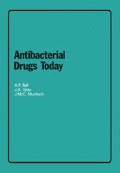Abstract
Erythromycin, triacetyloleandomycin and spiramycin are the best known of the macrolide group of antibiotics so called because their chemical structure is based on a macrocyclic lactone ring. Originally produced by Streptomyces erythreus waksman found in soil in the Philippines, they were subsequently purified and first used clinically in the 1950’s. The most widely used member, erythromycin, still enjoys an enviable reputation as an effective and virtually non-toxic antibacterial agent. A recent appraisal of erythromycin appears in the Scottish Medical Journal (1977).
Access this chapter
Tax calculation will be finalised at checkout
Purchases are for personal use only
Preview
Unable to display preview. Download preview PDF.
References
Bell, S.M.: A comparison of absorption after oral administration of erythromycin estolate and erythromycin stearate. Medical Journal of Australia 2: 1280–1283 (1971).
Garrod, L.P.: The erythromycin group of antibiotics. British Medical Journal 2: 57–63 (1957).
Garrod, L.P.; Lambert, H.P. and O’Grady, F.: Macrolides; in Antibiotic and Chemotherapy, 4th ed, p. 170 (Churchill Livingstone, Edinburgh and London 1973).
Kucers, A.: Spiramycin, oleandomycin and kitasamycin; in The Use of Antibiotics, p.223 (William Heinemann Medical Books, London 1972).
Lacey, R.W.: A new look at erythromycin. Postgraduate Medical Journal 53: 195–200 (1977).
Lake, B. and Bell, S.M.: Variations in absorption of erythromycin. Medical Journal of Australia 1: 449–451 (1969).
Oleinick, N.L. and Corcoran, J.W.: Two types of binding of erythromycin to ribosomes from antibiotic-sensitive and -resistant Bacillus subtilis 168. Journal of Biological Chemistry 244: 727–735 (1969).
Scottish Medical Journal: Erythromycin Symposium Issue 22: 5 (1977).
Wiegand, R.G. and Chun, A.H.C.: Serum protein binding of erythromycin and erythromycin 2-propio-nate ester. Journal of Pharmaceutical Sciences 61: 425–428 (1972).
Author information
Authors and Affiliations
Rights and permissions
Copyright information
© 1978 ADIS Press
About this chapter
Cite this chapter
Ball, A.P., Gray, J.A., Murdoch, J.M. (1978). The Macrolides. In: Antibacterial Drugs Today. Springer, Dordrecht. https://doi.org/10.1007/978-94-011-8004-7_9
Download citation
DOI: https://doi.org/10.1007/978-94-011-8004-7_9
Publisher Name: Springer, Dordrecht
Print ISBN: 978-0-85200-505-7
Online ISBN: 978-94-011-8004-7
eBook Packages: Springer Book Archive

